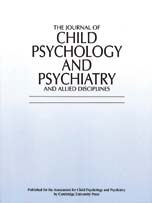Crossref Citations
This article has been cited by the following publications. This list is generated based on data provided by
Crossref.
Crimmins, Susan M.
Cleary, Sean D.
Brownstein, Henry H.
Spunt, Barry J.
and
Warley, Raquel Maria
2000.
Trauma, Drugs and Violence Among Juvenile Offenders.
Journal of Psychoactive Drugs,
Vol. 32,
Issue. 1,
p.
43.
Muller, Robert T
Goebel-Fabbri, Ann E
Diamond, Terry
and
Dinklage, David
2000.
Social support and the relationship between family and community violence exposure and psychopathology among high risk adolescents.
Child Abuse & Neglect,
Vol. 24,
Issue. 4,
p.
449.
Leventhal, Tama
and
Brooks-Gunn, Jeanne
2000.
The neighborhoods they live in: The effects of neighborhood residence on child and adolescent outcomes..
Psychological Bulletin,
Vol. 126,
Issue. 2,
p.
309.
Stichick, Theresa
2001.
The Psychosocial Impact of Armed Conflict on Children.
Child and Adolescent Psychiatric Clinics of North America,
Vol. 10,
Issue. 4,
p.
797.
van der Kolk, Bessel A.
and
Streeck-Fischer, Annette
2002.
Internationales Handbuch der Gewaltforschung.
p.
1020.
Guterman, Neil B
Hahm, Hyeouk C
and
Cameron, Mark
2002.
Adolescent victimization and subsequent use of mental health counseling services.
Journal of Adolescent Health,
Vol. 30,
Issue. 5,
p.
336.
Salzinger, Suzanne
Feldman, Richard S
Stockhammer, Tanya
and
Hood, Julie
2002.
An ecological framework for understanding risk for exposure to community violence and the effects of exposure on children and adolescents.
Aggression and Violent Behavior,
Vol. 7,
Issue. 5,
p.
423.
Pratt, Helen D.
and
Greydanus, Donald E.
2003.
Violence: concepts of its impact on children and youth.
Pediatric Clinics of North America,
Vol. 50,
Issue. 5,
p.
963.
Schwartz, David
and
Gorman, Andrea Hopmeyer
2003.
Community violence exposure and children's academic functioning..
Journal of Educational Psychology,
Vol. 95,
Issue. 1,
p.
163.
Chen, Edith
Fisher, Edwin B.
Bacharier, Leonard B.
and
Strunk, Robert C.
2003.
Socioeconomic Status, Stress, and Immune Markers in Adolescents With Asthma.
Psychosomatic Medicine,
Vol. 65,
Issue. 6,
p.
984.
Morenoff, Jeffrey D.
2003.
Neighborhood Mechanisms and the Spatial Dynamics of Birth Weight.
American Journal of Sociology,
Vol. 108,
Issue. 5,
p.
976.
Kassis, Wassilis
and
Steiner, Olivier
2003.
Persönlichkeitsmerkmale und soziale Erfahrungen von Mädchen, die extensiv gewaltdarstellende Computerspiele nutzen.
Zeitschrift für Medienpsychologie,
Vol. 15,
Issue. 4,
p.
131.
van der Kolk, Bessel A.
and
Streeck-Fischer, Annette
2003.
International Handbook of Violence Research.
p.
817.
Leventhal, Tama
Selner-O'Hagan, Mary Beth
Brooks-Gunn, Jeanne
Bingenheimer, Jeffrey
and
Earls, Felton
2004.
The Homelife Interview from the Project on Human Development in Chicago Neighborhoods: Assessment of Parenting and Home Environment for 3- to 15-Year-Olds.
Parenting,
Vol. 4,
Issue. 2,
p.
211.
Walsh, Christine
Jamieson, Ellen
MacMillan, Harriet
and
Trocmé, Nico
2004.
Measuring Child Sexual Abuse in Children and Youth.
Journal of Child Sexual Abuse,
Vol. 13,
Issue. 1,
p.
39.
Buckner, John C.
Beardslee, William R.
and
Bassuk, Ellen L.
2004.
Exposure to violence and low-income children's mental health: Direct, moderated, and mediated relations..
American Journal of Orthopsychiatry,
Vol. 74,
Issue. 4,
p.
413.
Lambert, Sharon F.
Ialongo, Nicholas S.
Boyd, Rhonda C.
and
Cooley, Michele R.
2005.
Risk Factors for Community Violence Exposure in Adolescence.
American Journal of Community Psychology,
Vol. 36,
Issue. 1-2,
p.
29.
Widom, Cathy Spatz
Dutton, Mary Ann
Czaja, Sally J.
and
DuMont, Kimberly A.
2005.
Development and validation of a new instrument to assess lifetime trauma and victimization history.
Journal of Traumatic Stress,
Vol. 18,
Issue. 5,
p.
519.
Alim, Tanya N.
Charney, Dennis S.
and
Mellman, Thomas A.
2006.
An overview of posttraumatic stress disorder in African Americans.
Journal of Clinical Psychology,
Vol. 62,
Issue. 7,
p.
801.
Voisin, Dexter R.
2007.
THE EFFECTS OF FAMILY AND COMMUNITY VIOLENCE EXPOSURE AMONG YOUTH: RECOMMENDATIONS FOR PRACTICE AND POLICY.
Journal of Social Work Education,
Vol. 43,
Issue. 1,
p.
51.


